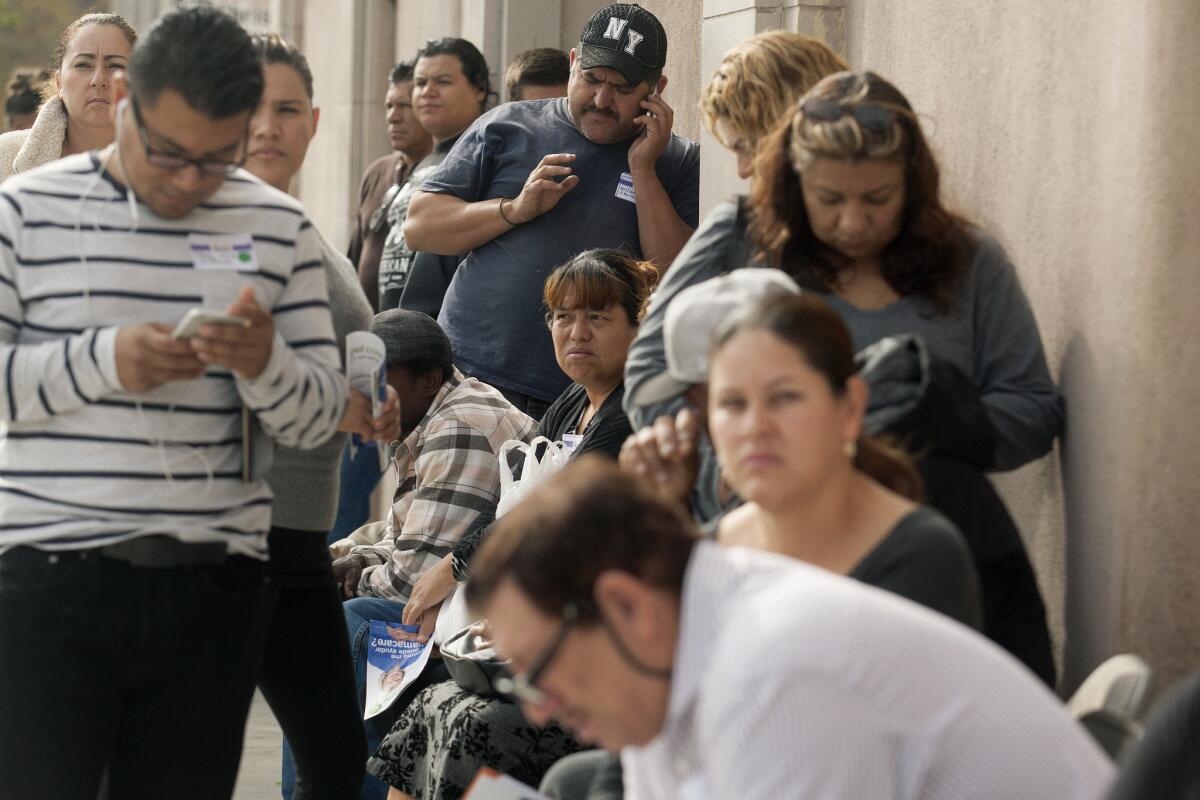The mortal threat to Medicaid -- and how to fix it

- Share via
Jan. 1 was a red-letter day for America’s provision of healthcare to its poorest residents--and we do mean red.
That was the expiration day of a two-year bump in Medicaid reimbursements for primary care physicians seeing Medicaid patients. The raise, which was part of the Affordable Care Act, temporarily raised Medicaid rates to the level of Medicare reimbursements; the expiration means a drop averaging nearly 43% nationwide, according to calculations by the Urban Institute.
The wider the gap between Medicare and pre-ACA Medicaid rates for primary care, the bigger the drop. In California, where primary care reimbursements for Medi-Cal, the state’s Medicaid program, are among the lowest in the country, the drop in reimbursements will be close to 59%. The consequences are self-evident. As the Urban Institute observes: “Significant drops in primary care reimbursement may lead physicians to see fewer Medicaid patients, potentially leading these patients to have difficulty finding a physician or getting an appointment.”
The ACA gave states the option of continuing the Medicaid raise from their own funds. Unsurprisingly, most have declined to do so. The Urban Institute found only 15 states that had decided to continue the higher reimbursements, and 12 others that were “undecided” as of the date of its survey, which was published in December.
California is not among them, even though its Medicaid enrollment of nearly 12 million was the highest in the country--twice the level of the No. 2 state, New York--even before the state expanded the program under the Affordable Care Act. Interestingly, the Urban Institute found no pattern linking states that have expanded Medicaid and those that have decided against maintaining doctors’ pay--California, for example, has expanded Medi-Cal, but won’t keep the higher reimbursements. Six of the 22 states that have thus far shunned Medicaid expansion have decided to maintain the higher physician rates. (Gov. Jerry Brown didn’t offer to maintain the Medi-Cal rates in his State of the State message Monday.)
The reason for the disconnect may be that the expansion will be 100% covered by the federal government through 2016, after which the federal share declines to a permanent 90% in 2020 and beyond. Maintaining the higher reimbursements, however, is on the states’ dime.
The plunge in reimbursements seems certain to be a discouraging factor, raising concerns about whether enrollees will actually be able to see a primary care physician. The expansion has added more than 2.2 million new enrollees to Medi-Cal. But as my colleague Eryn Brown reported last week, the number of full-time primary-care doctors per 100,000 Medi-Cal enrollees already ranges from 35 to 49, well short of the federal government’s recommended 60 to 80.
The only bright side of the situation is that the change in reimbursements doesn’t apply to specialists and is moderated for those treating Medicaid patients through so-called Medicaid Advantaged managed care plans. In California, that’s about 80% of enrollees.
The drop in primary-care reimbursements and its consequences are certain to fuel conservatives’ habitual animosity to the program, which is aimed at the nation’s poorest and sickest residents. Conservative healthcare pundit Avik Roy has been on this warpath for years, calling Medicaid “America’s worst health-care program.”
It might be that, except that no healthcare program, which is the option faced by millions of new Medicaid beneficiaries before getting enrolled under the ACA, is plainly worse. Critics such as Roy observe that some studies show that patients without insurance sometimes fare better than those on Medicaid, but these studies often acknowledge that the Medicaid population’s health is measurably worse than that of the uninsured, in ways that are difficult to correct for.
What Medicaid’s critics fail to concede is that whatever structural problems ail Medicaid, they’re overwhelmed by one malady: lack of money. Medicaid is famous for its low reimbursements: a 25-minute office consultation with a return patient can earn a primary care physician as little as $37.50 in California, according to state records. The national Medicare reimbursement in 2013 was $106.83. The low rate means that Medicaid patients will tend to be seen by the most inexperienced and overworked doctors, another factor that may contribute to their health outcomes.
To keep the Medicaid reimbursement at 2014 levels would cost the federal government about $3.8 billion a year. That’s about a 10th of one percent of the federal budget, and three-quarters of 1 percent of the government’s net outlay for Medicare. Congress could fund the sum in its sofa cushions, if it so chose, and would make up the cost in improved health and more effective healthcare for Americans. But President Obama’s proposal last March to extend the raise for another year went unanswered by Congress, although lawmakers customarily avert Medicare reimbursement cuts through special legislation, the “doc fix,” every year. The received wisdom is that a similar proposal on Medicaid would get an even chillier reception on Capitol Hill this year.
This is yet another example of the U.S. failing to put its money where its mouth is on healthcare. There’s no doubt that increasing pay for Medicaid primary care physicians would bear dividends. As the new year dawned, it was clear that the talk in Washington of making America’s public healthcare system work better for Americans was all talk, and that talk was cheap.
Keep up to date with the Economy Hub. Follow @hiltzikm on Twitter, see our Facebook page, or email mhiltzik@latimes.com.
More to Read
Inside the business of entertainment
The Wide Shot brings you news, analysis and insights on everything from streaming wars to production — and what it all means for the future.
You may occasionally receive promotional content from the Los Angeles Times.











